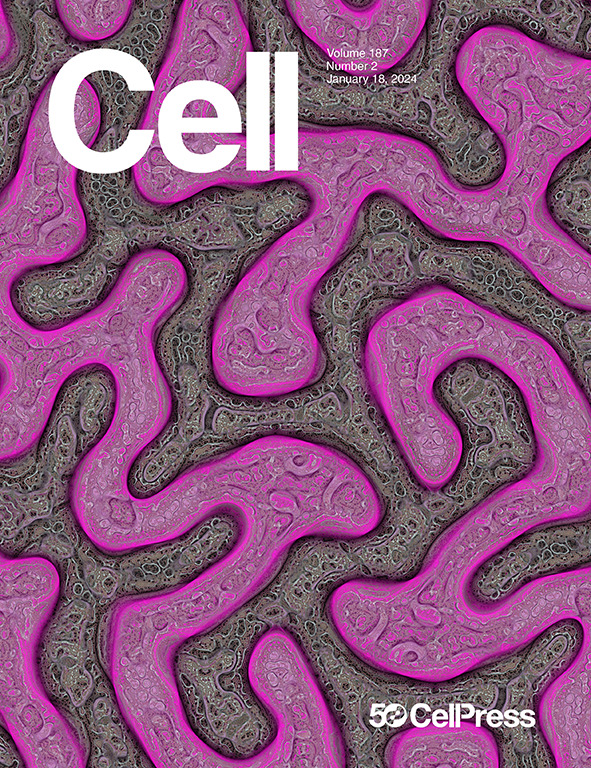DNA结合和有丝分裂磷酸化保护聚谷氨酰胺蛋白免于组装形成
IF 45.5
1区 生物学
Q1 BIOCHEMISTRY & MOLECULAR BIOLOGY
引用次数: 0
摘要
在神经退行性疾病中,聚谷氨酰胺(polyQ)扩增与致病性蛋白聚集有关。然而,在许多转录因子(TF)中也发现了长多q束,例如FOXP2,一种与人类语言有关的TF。在这里,我们探索FOXP2和其他富含谷氨酰胺的tf如何避免计划外组装。在整个间期,DNA结合,无论序列特异性如何,都具有溶解作用。在有丝分裂过程中,多重磷酸化事件促进FOXP2从染色质中被驱逐并取代DNA的溶解功能。此外,与语言进化相关的人类特异性氨基酸替换映射到有丝分裂磷酸化补丁,即“EVO补丁”,并降低了人类FOXP2组装的倾向。将致病形式的亨廷顿蛋白融合到dna结合结构域、EVO贴片的拟磷变体或带负电荷的肽上,足以减少组装的形成,这表明控制富含谷氨酰胺的tf溶解度的劫持机制可能为治疗多q扩增性疾病提供新的策略。本文章由计算机程序翻译,如有差异,请以英文原文为准。

DNA binding and mitotic phosphorylation protect polyglutamine proteins from assembly formation
Polyglutamine (polyQ) expansion is associated with pathogenic protein aggregation in neurodegenerative disorders. However, long polyQ tracts are also found in many transcription factors (TFs), such as FOXP2, a TF implicated in human speech. Here, we explore how FOXP2 and other glutamine-rich TFs avoid unscheduled assembly. Throughout interphase, DNA binding, irrespective of sequence specificity, has a solubilizing effect. During mitosis, multiple phosphorylation events promote FOXP2’s eviction from chromatin and supplant the solubilizing function of DNA. Further, human-specific amino acid substitutions linked to the evolution of speech map to a mitotic phospho-patch, the “EVO patch,” and reduce the propensity of the human FOXP2 to assemble. Fusing the pathogenic form of Huntingtin to either a DNA-binding domain, a phosphomimetic variant of this EVO patch, or a negatively charged peptide is sufficient to diminish assembly formation, suggesting that hijacking mechanisms governing solubility of glutamine-rich TFs may offer new strategies for treatment of polyQ expansion diseases.
求助全文
通过发布文献求助,成功后即可免费获取论文全文。
去求助
来源期刊

Cell
生物-生化与分子生物学
CiteScore
110.00
自引率
0.80%
发文量
396
审稿时长
2 months
期刊介绍:
Cells is an international, peer-reviewed, open access journal that focuses on cell biology, molecular biology, and biophysics. It is affiliated with several societies, including the Spanish Society for Biochemistry and Molecular Biology (SEBBM), Nordic Autophagy Society (NAS), Spanish Society of Hematology and Hemotherapy (SEHH), and Society for Regenerative Medicine (Russian Federation) (RPO).
The journal publishes research findings of significant importance in various areas of experimental biology, such as cell biology, molecular biology, neuroscience, immunology, virology, microbiology, cancer, human genetics, systems biology, signaling, and disease mechanisms and therapeutics. The primary criterion for considering papers is whether the results contribute to significant conceptual advances or raise thought-provoking questions and hypotheses related to interesting and important biological inquiries.
In addition to primary research articles presented in four formats, Cells also features review and opinion articles in its "leading edge" section, discussing recent research advancements and topics of interest to its wide readership.
 求助内容:
求助内容: 应助结果提醒方式:
应助结果提醒方式:


